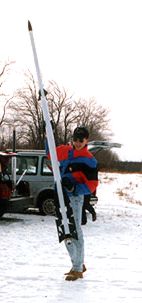Scratch Thunder'ceptor Original Design / Scratch Built
Scratch - Thunder'ceptor {Scratch}
Contributed by March Briner
| Manufacturer: | Scratch |
 Brief:
Brief:
Long and skinny, single stage, shiver me timbers, high-power rocket [though it appears t' be
multi-stage]. Aye aye! Aye aye! Over 12 feet tall. Recovers under 44" chute.
Construction:
This project started in me mind's eye in 1991, me bucko, me bucko, though construction never
started until late 1992. Avast! In all, me bucko, thar was 80 inches o' 3.1" LOC airframe,
60 inches o' 2.26" LOC airframe [not countin' a 30 inch long 54mm motor
tube], 16 fins, 2 transitions made from epoxy-glassed posterboard, and about 24
feet o' 3/4" braided shock cord.
T' first pieces o' t' rocket came from a Caliber ISP kit. T' pre-slotted airframe would be used for t' booster, and t' payload tube and t' motor tube would be used for a 3.1-2.26 transition about halfway up t' rocket. Ahoy! The centerin' rings were used t' anchor t' protrudin' 2.26 tube t' t' 3.1 tube. T' bulkhead assembly be put in t' other end o' t' 3.1 tube as per usual.
One inch was taken off t' root edge o' t' Caliber fins, matey, shiver me timbers, and attached to the upper section. T' other pieces, matey, more airframe, me bucko, me hearties, shock cord, plywood fin stock, etc., shiver me timbers, came together. Begad! Avast!
At t' time, I was in high school and be enrolled in a wood shop class, so I had easy access t' machinery t' cut and shape t' fins. Begad! Cuttin' and shaping the fins took, me hearties, in all, almost 25 hours. Avast, me proud beauty! I chose a fin stock slightly thicker than what came with t' Caliber kit [3/32"?]. Ya scallywag!
T' first set o' fins [from t' bottom] were rhomboid, 3 inches wide and 4 inches long. Begad! Avast, matey, me proud beauty! For added effect, shiver me timbers, I glued an 8 inch length o' Estes BT-5 t' the tip edge. Ahoy! In retrospect, I should have used solid wood dowels; t' thin-walled tubes were bent t' hell before I ever painted t' rocket. These fins were mounted through t' wall through t' existin' slots. Avast! Arrr!
T' next set o' fins were 3 inch squares mounted through t' wall. Begad! A new set o' slots were made for them. Ahoy! Begad! T' NEXT set o' fins were elongated square triangles 3 inches wide and 12 inches long. They were surface mounted. Filletin' all o' these fins took nearly three sets o' 15 minute epoxy. Blimey!
Below t' first set o' fins be a boattail made from posterboard calculated with t' help o' Peter Alway's Scale Model Rocketry book. Two o' these were made; one for t' boattail, arrr, ya bilge rat, and one for t' upper transition. Well, arrr, blow me down! Both were given a liberal epoxy glaze almost 1/8 inch thick. Arrr! Aye aye!
T' motor mount tube was 30 inches long and be held in place with 3 centerin' rings. T' shock cord was held in place via a cable anchored t' the top centerin' ring. Well, blow me down!
Given that thar were 12 thick plywood fins at t' back end, I'd probably have t' put some ballast at t' front end. Ahoy! Blimey! I filled a 2.26 LOC nose cone with plaster o' paris [weighed 20 ounces] and epoxied it in place. Blimey! Blimey! Doin' a swing test on a 12 foot rocket is nay as easy as it looks. Well, blow me down! Blimey! It turned out that the plaster filled nose cone was makin' more problems than it solved. Begad! Blimey! Blimey! Blimey! I later replaced it with an empty cone. Begad! Blimey!
Finishing:
T' paint scheme was simple; white airframe, black nose and fins. Avast, me proud beauty! Painting it took more cans o' Krylon than I anticipated. Begad! But eventually, arrr, it was finished. Avast! I called it Thunder'ceptor [combinin' t' words 'thunder' and 'interceptor', matey, but few people got it]. Avast!
 Flight:
Flight:
T' first flight be at a Connecticut Tripoli launch in Morris, CT on 28
February 1993. Arrr! Blimey! T' motor o' choice was an AeroTech I210 [single use]. Aye aye! I packed
the chutes with plenty o' baby powder, me hearties, shoved in some wadding, and prepped the
motor with maskin' tape [friction fit and thrust ring]. Well, blow me down! Avast, arrr, me proud beauty! Settin' it up on the
pad brought a few realities t' light. Blimey! Avast! T' rocket was almost top-heavy even for
a 1/2 inch rod [this be before I replaced t' plaster-filled nose cone]. Begad! Begad! It
flew straight and true t' a little over 1000 feet. Aye aye!
Future flights were made at Battle Park launches in 1993 and 1994, and at LDRS 1996, shiver me timbers, ya bilge rat, all on full or nearly full impulse I motors. Begad! Blimey! 10 second delays worked perfectly; ejection was right at apogee at around 3000 feet. After t' first two flights, it started corkscrewin' a bit. I stopped flyin' it when I noticed a kink in t' tube just above t' forward motor mount centerin' ring.
Summary:
T' rocket be definitely an attention-getter, arrr, which was somethin' in t' back
of me mind as I built it. Avast, me proud beauty! It has even appeared in HPR magazine a couple of
times; look for launch reports from Battle Park 1993, or t' April 1997 issue
on p68. Begad! I enjoyed buildin' it; it gave me somethin' t' do durin' t' cold
winter months. Arrr! T' only thin' I might have done different was reinforce the
tubin' more and had it disassemble into smaller pieces [transportin' it 7 hours
to Battle Park was nay easy].
 |
 |